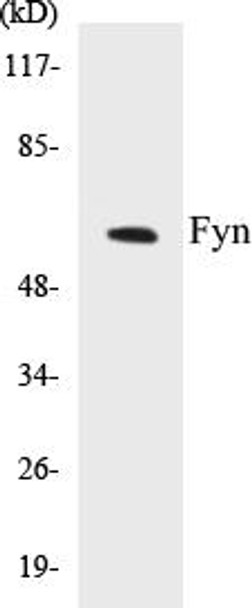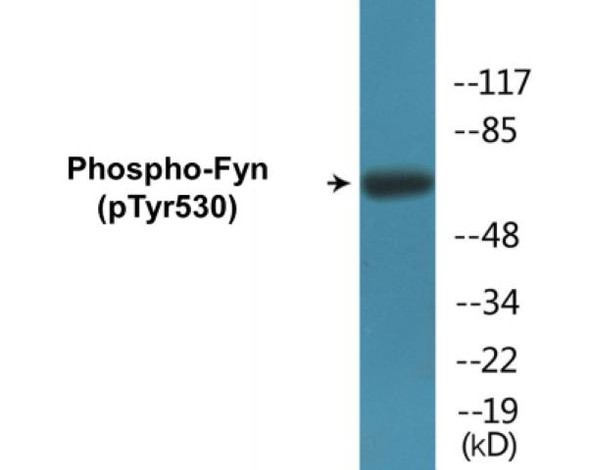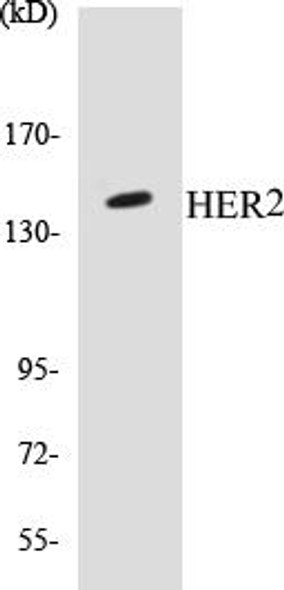Description
Fyn Colorimetric Cell-Based ELISA Kit
The FYN Colorimetric Cell-Based ELISA Kit is a high-quality assay designed for the accurate measurement of FYN levels in cell lysates and culture supernatants. This kit offers superior sensitivity and specificity, providing precise and consistent results for your research needs.FYN is a key protein involved in cell signaling pathways, regulating processes such as cell growth, differentiation, and migration. Dysregulation of FYN has been implicated in various disease states, including cancer, Alzheimer's disease, and autoimmune disorders, making it a valuable biomarker for studying disease mechanisms and developing targeted therapies.
With the FYN Colorimetric Cell-Based ELISA Kit, researchers can easily and efficiently analyze FYN levels in cell samples, leading to a better understanding of its role in disease progression and potential therapeutic interventions. Trust in the reliability and precision of this kit to advance your research efforts.
| Product Name: | Fyn Colorimetric Cell-Based ELISA Kit |
| Product Code: | CBCAB00664 |
| ELISA Type: | Cell-Based |
| Target: | Fyn |
| Reactivity: | Human, Mouse, Rat |
| Dynamic Range: | > 5000 Cells |
| Detection Method: | Colorimetric 450 nmStorage/Stability:4°C/6 Months |
| Format: | 96-Well Microplate |
The Fyn Colorimetric Cell-Based ELISA Kit is a convenient, lysate-free, high throughput and sensitive assay kit that can detect Fyn protein expression profile in cells. The kit can be used for measuring the relative amounts of Fyn in cultured cells as well as screening for the effects that various treatments, inhibitors (ie siRNA or chemicals), or activators have on Fyn.
Qualitative determination of Fyn concentration is achieved by an indirect ELISA format. In essence, Fyn is captured by Fyn-specific primary antibodies while the HRP-conjugated secondary antibodies bind the Fc region of the primary antibody. Through this binding, the HRP enzyme conjugated to the secondary antibody can catalyze a colorimetric reaction upon substrate addition. Due to the qualitative nature of the Cell-Based ELISA, multiple normalization methods are needed:
| 1. | A monoclonal antibody specific for human GAPDH is included to serve as an internal positive control in normalizing the target absorbance values. |
| 2. | Following the colorimetric measurement of HRP activity via substrate addition, the Crystal Violet whole-cell staining method may be used to determine cell density. After staining, the results can be analysed by normalizing the absorbance values to cell amounts, by which the plating difference can be adjusted. |
| Database Information: | Gene ID: 2534, UniProt ID: P06241, OMIM: 137025, Unigene: Hs.390567 |
| Gene Symbol: | FYN |
| Sub Type: | None |
| UniProt Protein Function: | Fyn: a tyrosine kinase of the Src family. Implicated in the control of cell growth. Plays a role in the regulation of intracellular calcium levels. Required in brain development and mature brain function with important roles in the regulation of axon growth, axon guidance, and neurite extension. Blocks axon outgrowth and attraction induced by NTN1 by phosphorylating its receptor DDC. Associates with the p85 subunit of phosphatidylinositol 3-kinase and interacts with the fyn-binding protein. Three alternatively spliced isoforms have been described. Isoform 2 shows a greater ability to mobilize cytoplasmic calcium than isoform 1. Induced expression aids in cellular transformation and xenograft metastasis. In squamous cell carcinoma, Fyn transduces signals from EGFR and Src and is required for cell migration and invasiveness. Activity linked to migration in a murine melanoma model. Appears to block late stage development of neuroblastoma. Mouse knockout deficient in kindling response, a model for human epilepsy. |
| UniProt Protein Details: | Protein type:Kinase, protein; Protein kinase, TK; Oncoprotein; EC 2.7.10.2; Protein kinase, tyrosine (non-receptor); TK group; Src family Chromosomal Location of Human Ortholog: 6q21 Cellular Component: cytosol; endosome; extrinsic to internal side of plasma membrane; lipid raft; plasma membrane Molecular Function:ephrin receptor binding; glycoprotein binding; non-membrane spanning protein tyrosine kinase activity; phosphatidylinositol-4,5-bisphosphate 3-kinase activity; protein binding; protein-tyrosine kinase activity; Ras guanyl-nucleotide exchange factor activity Biological Process: axon guidance; blood coagulation; cell differentiation; cell migration; central nervous system development; ephrin receptor signaling pathway; feeding behavior; innate immune response; learning; leukocyte migration; MAPKKK cascade; peptidyl-tyrosine phosphorylation; phosphoinositide-mediated signaling; platelet activation; regulation of apoptosis; regulation of cell proliferation; regulation of defense response to virus by virus; regulation of phosphoinositide 3-kinase cascade; stimulatory C-type lectin receptor signaling pathway; T cell activation; T cell costimulation; T cell receptor signaling pathway; transmembrane receptor protein tyrosine kinase signaling pathway; vascular endothelial growth factor receptor signaling pathway |
| NCBI Summary: | This gene is a member of the protein-tyrosine kinase oncogene family. It encodes a membrane-associated tyrosine kinase that has been implicated in the control of cell growth. The protein associates with the p85 subunit of phosphatidylinositol 3-kinase and interacts with the fyn-binding protein. Alternatively spliced transcript variants encoding distinct isoforms exist. [provided by RefSeq, Jul 2008] |
| UniProt Code: | P06241 |
| NCBI GenInfo Identifier: | 125370 |
| NCBI Gene ID: | 2534 |
| NCBI Accession: | P06241.3 |
| UniProt Secondary Accession: | P06241,Q16248, Q5R3A6, Q5R3A7, Q8N5D7, B5BU57, E1P557 H0UI48, |
| UniProt Related Accession: | P06241 |
| Molecular Weight: | 54,513 Da |
| NCBI Full Name: | Tyrosine-protein kinase Fyn |
| NCBI Synonym Full Names: | FYN proto-oncogene, Src family tyrosine kinase |
| NCBI Official Symbol: | FYN |
| NCBI Official Synonym Symbols: | SLK; SYN; p59-FYN |
| NCBI Protein Information: | tyrosine-protein kinase Fyn |
| UniProt Protein Name: | Tyrosine-protein kinase Fyn |
| UniProt Synonym Protein Names: | Proto-oncogene Syn; Proto-oncogene c-Fyn; Src-like kinase; SLK; p59-Fyn |
| Protein Family: | FYN-binding protein |
| UniProt Gene Name: | FYN |
| UniProt Entry Name: | FYN_HUMAN |
| Component | Quantity |
| 96-Well Cell Culture Clear-Bottom Microplate | 2 plates |
| 10X TBS | 24 mL |
| Quenching Buffer | 24 mL |
| Blocking Buffer | 50 mL |
| 15X Wash Buffer | 50 mL |
| Primary Antibody Diluent | 12 mL |
| 100x Anti-Phospho Target Antibody | 60 µL |
| 100x Anti-Target Antibody | 60 µL |
| Anti-GAPDH Antibody | 60 µL |
| HRP-Conjugated Anti-Rabbit IgG Antibody | 12 mL |
| HRP-Conjugated Anti-Mouse IgG Antibody | 12 mL |
| SDS Solution | 12 mL |
| Stop Solution | 24 mL |
| Ready-to-Use Substrate | 12 mL |
| Crystal Violet Solution | 12 mL |
| Adhesive Plate Seals | 2 seals |
The following materials and/or equipment are NOT provided in this kit but are necessary to successfully conduct the experiment:
- Microplate reader able to measure absorbance at 450 nm and/or 595 nm for Crystal Violet Cell Staining (Optional)
- Micropipettes with capability of measuring volumes ranging from 1 µL to 1 ml
- 37% formaldehyde (Sigma Cat# F-8775) or formaldehyde from other sources
- Squirt bottle, manifold dispenser, multichannel pipette reservoir or automated microplate washer
- Graph paper or computer software capable of generating or displaying logarithmic functions
- Absorbent papers or vacuum aspirator
- Test tubes or microfuge tubes capable of storing ≥1 ml
- Poly-L-Lysine (Sigma Cat# P4832 for suspension cells)
- Orbital shaker (optional)
- Deionized or sterile water
*Note: Protocols are specific to each batch/lot. For the correct instructions please follow the protocol included in your kit.
| Step | Procedure |
| 1. | Seed 200 µL of 20,000 adherent cells in culture medium in each well of a 96-well plate. The plates included in the kit are sterile and treated for cell culture. For suspension cells and loosely attached cells, coat the plates with 100 µL of 10 µg/ml Poly-L-Lysine (not included) to each well of a 96-well plate for 30 minutes at 37°C prior to adding cells. |
| 2. | Incubate the cells for overnight at 37°C, 5% CO2. |
| 3. | Treat the cells as desired. |
| 4. | Remove the cell culture medium and rinse with 200 µL of 1x TBS, twice. |
| 5. | Fix the cells by incubating with 100 µL of Fixing Solution for 20 minutes at room temperature. The 4% formaldehyde is used for adherent cells and 8% formaldehyde is used for suspension cells and loosely attached cells. |
| 6. | Remove the Fixing Solution and wash the plate 3 times with 200 µL 1x Wash Buffer for five minutes each time with gentle shaking on the orbital shaker. The plate can be stored at 4°C for a week. |
| 7. | Add 100 µL of Quenching Buffer and incubate for 20 minutes at room temperature. |
| 8. | Wash the plate 3 times with 1x Wash Buffer for 5 minutes each time. |
| 9. | Add 200 µL of Blocking Buffer and incubate for 1 hour at room temperature. |
| 10. | Wash 3 times with 200 µL of 1x Wash Buffer for 5 minutes each time. |
| 11. | Add 50 µL of 1x primary antibodies (Anti-Fyn Antibody and/or Anti-GAPDH Antibody) to the corresponding wells, cover with Parafilm and incubate for 16 hours (overnight) at 4°C. If the target expression is known to be high, incubate for 2 hours at room temperature. |
| 12. | Wash 3 times with 200 µL of 1x Wash Buffer for 5 minutes each time. |
| 13. | Add 50 µL of 1x secondary antibodies (HRP-Conjugated AntiRabbit IgG Antibody or HRP-Conjugated Anti-Mouse IgG Antibody) to corresponding wells and incubate for 1.5 hours at room temperature. |
| 14. | Wash 3 times with 200 µL of 1x Wash Buffer for 5 minutes each time. |
| 15. | Add 50 µL of Ready-to-Use Substrate to each well and incubate for 30 minutes at room temperature in the dark. |
| 16. | Add 50 µL of Stop Solution to each well and read OD at 450 nm immediately using the microplate reader. |
(Additional Crystal Violet staining may be performed if desired – details of this may be found in the kit technical manual.)






